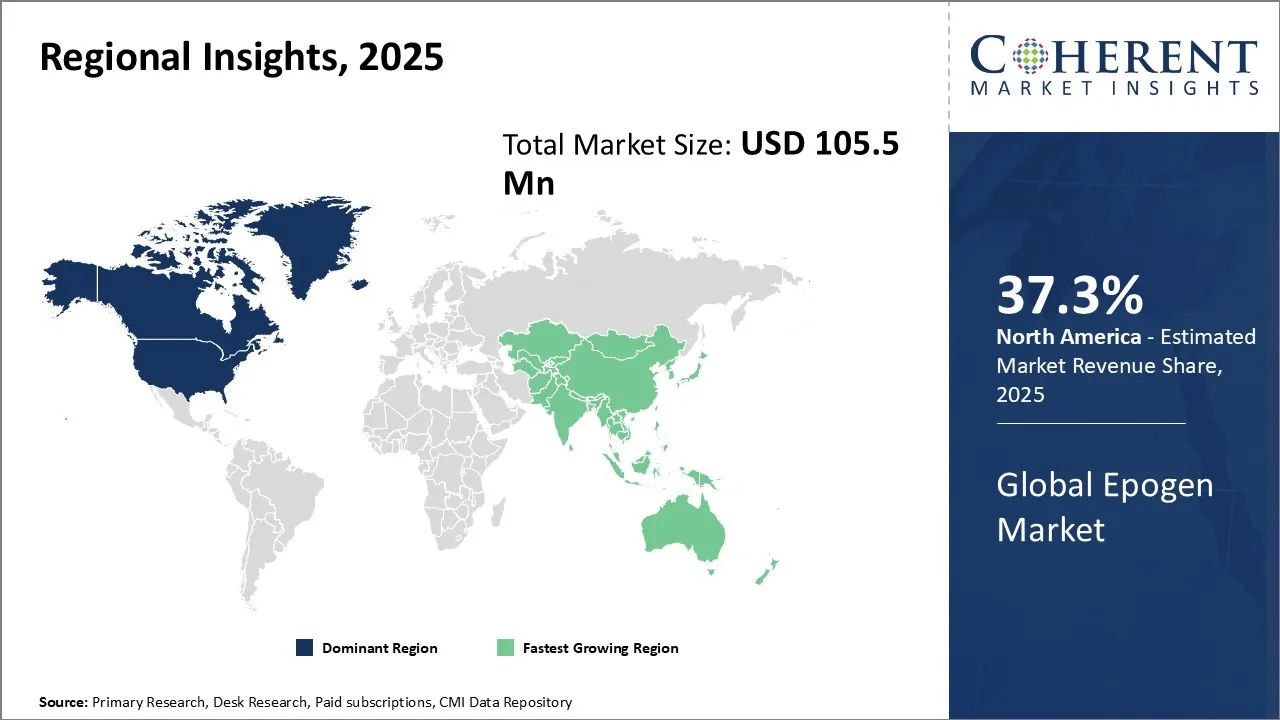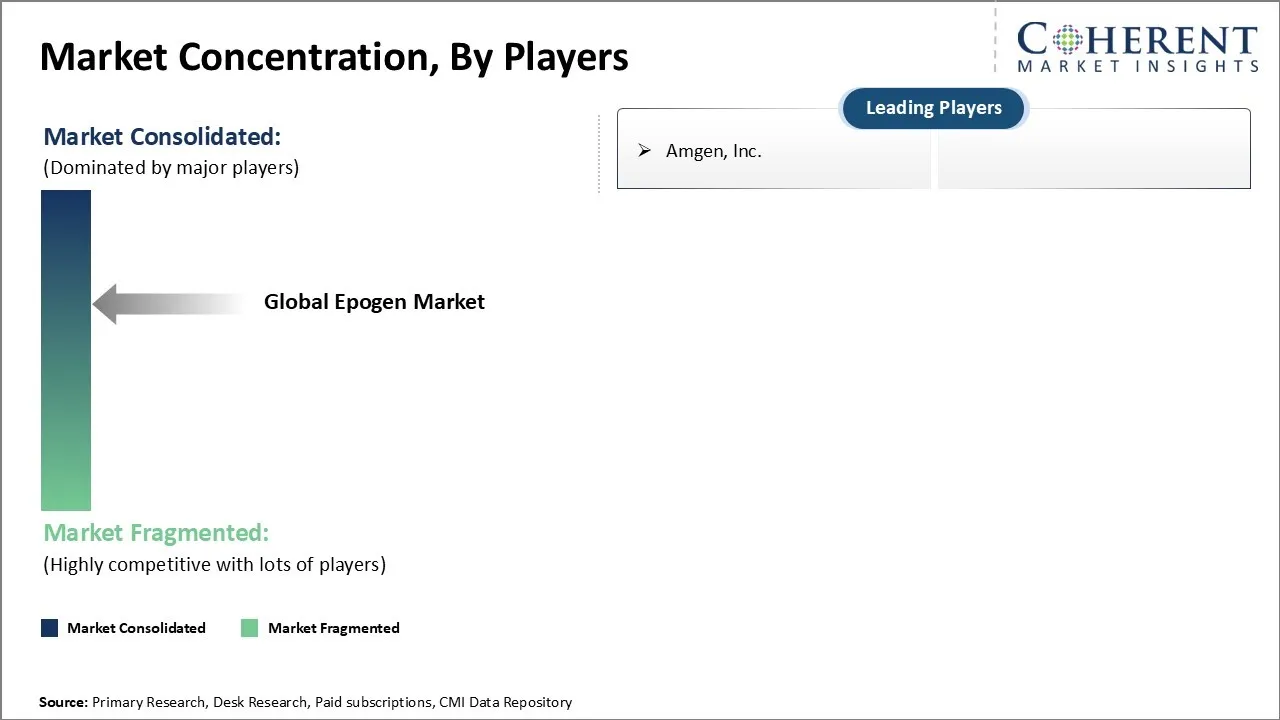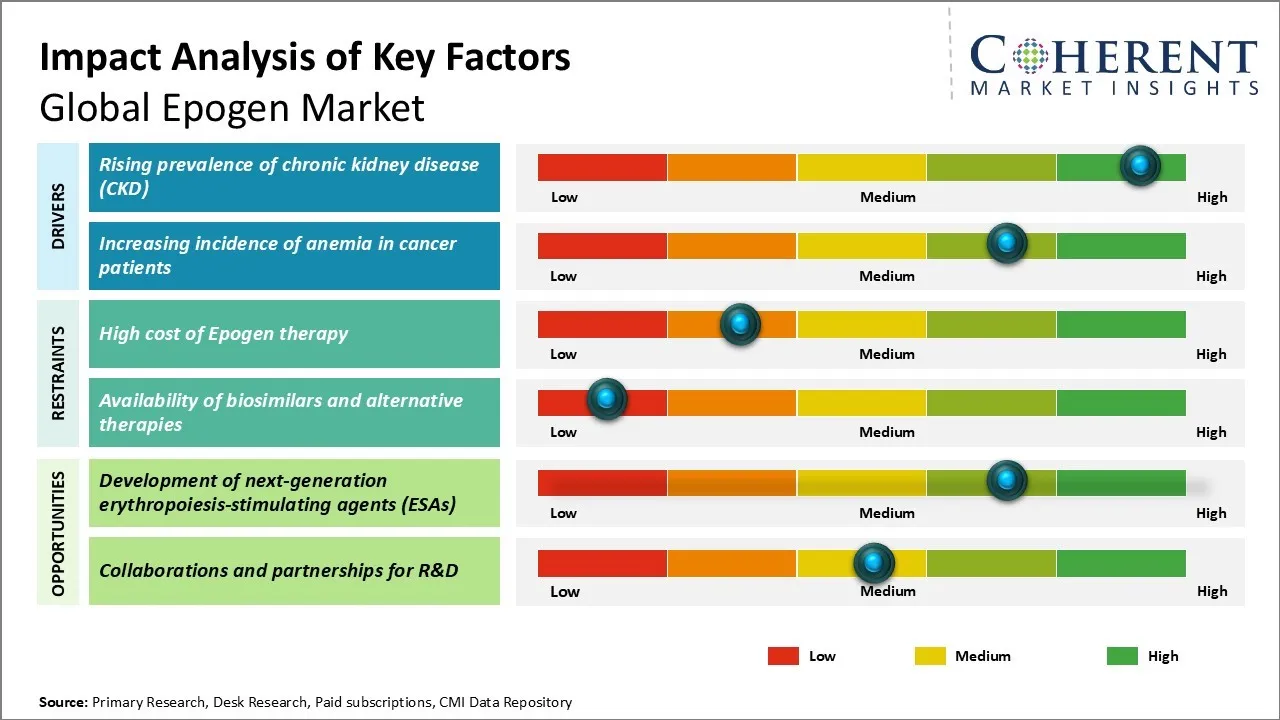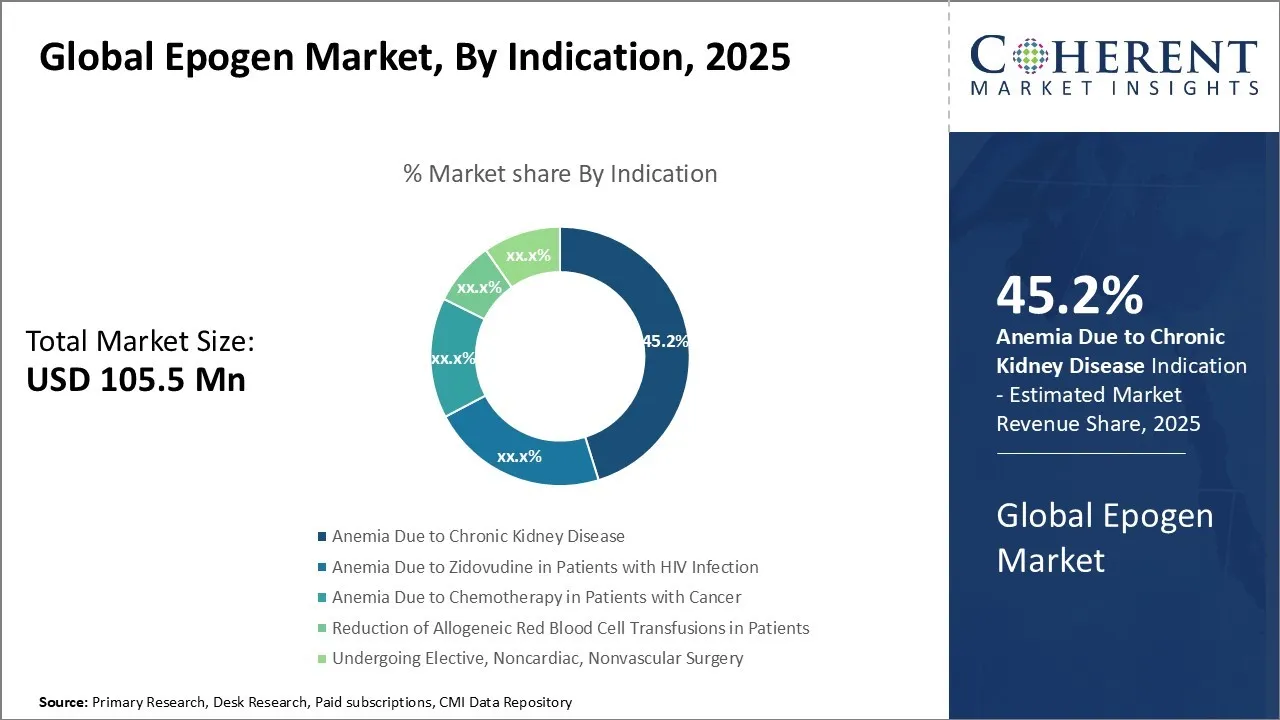Global Epogen Market Size and Forecast
The Global Epogen Market is estimated to be valued at USD 105.5 Mn in 2025 and is expected to reach USD 32.1 Mn by 2032, exhibiting a compound annual growth rate (CAGR) of -15.6% from 2025 to 2032. This decline reflects shifting dynamics within the industry, influenced by various market forces and evolving healthcare priorities over the forecast period.
Key Takeaways of the global Epogen market
- Anemia due to chronic kidney disease represents the largest indication segment in the global Epogen market, accounting for an estimated 45.2% of total consumption in 2025.
- By strength, the 2,000 Units/mL concentration leads with an estimated 32.4% share, reflecting its widespread clinical use.
- By dosage form, within injection formats, single-dose vials are projected to lead the market with around 64% share in 2025.
- North America is expected to lead the market, holding a share of 37.3% in 2025. Asia Pacific is anticipated to be the fastest-growing region, with a market share of 25.3% in 2025.
Market Overview
The market trend highlights a significant contraction in demand for Epogen products, driven primarily by the introduction of alternative therapies and biosimilars that offer more cost-effective solutions. Additionally, increasing regulatory challenges and patent expirations are pushing existing players to innovate or pivot their strategies. As a result, stakeholders are focusing on improving product efficacy and exploring new indications to counterbalance the negative growth trajectory observed in this market segment.
Currents Events and their Impact
|
Current Events |
Description and its impact |
|
Expansion of Biosimilar Manufacturing Capacity in Europe |
|
|
Technological Advancements in Anemia Management |
|
Uncover macros and micros vetted on 75+ parameters: Get instant access to report
Epogen Market Insights, By Indication - Efficacy in Managing Anemia Due to Chronic Kidney Disease Fuels Dominance in Epogen Market
In terms of indication, anemia due to chronic kidney disease stands out as the most significant contributor to the global Epogen market with an estimated share of 45.2% in 2025. This prominence primarily stems from the well-established clinical need for effective anemia management in chronic kidney disease (CKD) patients, a population that experiences a high prevalence of erythropoietin deficiency leading to severe anemia. Epogen, being a recombinant human erythropoietin, directly addresses this deficiency by stimulating red blood cell production, thus significantly improving patient quality of life.
The chronic nature of kidney disease necessitates long-term and consistent treatment protocols, and Epogen fits well within this therapeutic framework. As kidney function deteriorates, the endogenous production of erythropoietin decreases, making exogenous supplementation indispensable. Additionally, anemia in CKD patients is closely linked to adverse outcomes, including increased cardiovascular risk and mortality, which further underscores the critical role Epogen plays in managing this condition. Healthcare providers increasingly prefer Epogen due to its proven efficacy and established safety profile in this cohort.
For instance, in October 2022, a recent single-center study from Hyderabad, India, found a high prevalence of anemia (82.4%) among chronic kidney disease (CKD) patients. Conducted over six months with 715 participants, the research revealed that anemia was strongly associated with hypertension, diabetes, and advanced CKD stages. The authors emphasize that early assessment and management of anemia could significantly improve patient outcomes as CKD progresses.
Epogen Market Insights, By Strength - Preference for Low-Dose Strengths Drives Prominence of 2,000 Units/mL in Epogen Therapy
In terms of strength, the 2,000 Units/mL concentration maintains the highest market share among the various Epogen formulations with an estimated share of 32.4% in 2025. This preference can be attributed to several key factors closely linked to dosing flexibility, patient safety, and clinical convenience. Primarily, the 2000 Units/mL dosage offers a balance that accommodates a broad range of anemia severities, allowing physicians to tailor treatment effectively without excessive dosing, which can lead to adverse events such as hypertension or increased thrombotic risk.
Clinicians often start patients on lower to moderate strength doses, adjusting upward as needed, making 2,000 Units/mL an optimal starting point that aligns well with treatment algorithms, especially in early or moderate anemia stages. This strength also lends itself to accurate dose titration in chronic diseases like CKD-related anemia where patient response can vary significantly. Additionally, the intermediate concentration reduces waste during administration, enhancing cost-effectiveness.
Epogen Market Insights, By Dosage Form - Injection Form Dominates Due to Ease of Administration and Patient Compliance
By dosage form, the injection segment accounts for the largest share of market consumption, mainly due to its practical benefits in clinical use and better patient adherence. Among injections, single-dose vials hold the leading share at approximately 64% in 2025, favored for their lower contamination risk, precise dosing, and alignment with hospital protocols. Injections ensure the direct and rapid bioavailability of erythropoietin, which is critical for timely correction of anemia symptoms. This immediate onset of action is especially important in patients requiring acute management, such as those undergoing chemotherapy or elective surgeries, where rapid hemoglobin recovery can reduce complications.
The injection dosage form dominates Epogen consumption due to its rapid bioavailability and ease of administration in clinical settings. Multi-dose vials, accounting for about 36%, are mainly used in high-volume facilities where cost efficiency and reduced packaging waste are priorities.
Pricing Analysis of Epogen Market
- The price of Epogen (epoetin alfa) varies widely across countries and dosage strengths. In the United States, a 2,000 UNITS/ML vial averages around USD 358, while in Germany and France the same vial costs approximately USD 112 and USD 62, respectively. Higher-strength formats, such as 20,000 UNITS/ML, can exceed USD 2,900 in the U.S., reflecting higher production costs and less aggressive price controls compared to Europe. Countries like Malaysia and Saudi Arabia report some of the lowest prices due to government negotiations and lower demand.
- Looking ahead, prices are expected to decline by up to 40% by 2032 as biosimilars like Retacrit gain market share and newer anemia treatments emerge. Key pricing drivers include complex biologic manufacturing, loss of patent exclusivity, insurance coverage variations, and government regulations. Biosimilar competition and tighter pricing policies, especially in Europe and parts of Asia-Pacific, will likely intensify downward pressure on Epogen’s cost over the next decade.
Regional Insights

To learn more about this report, Download Free Sample
North America Epogen Market Analysis and Trends
In North America, the market is expected to retain the largest share of 37.3% in 2025, despite experiencing a gradual decline marked by slow growth and a negative CAGR. This contraction is primarily due to increasing biosimilar competition, pricing pressures, and the shift toward alternative anemia therapies. While the region benefits from a well-established healthcare infrastructure and robust reimbursement systems, saturation in key treatment segments and patent expirations have limited further expansion.
The U.S. continues to be a significant market, supported by major pharmaceutical companies such as Amgen Inc., the original developer of Epogen (epoetin alfa). However, cost-containment measures, stricter formulary controls, and the widespread availability of lower-cost biosimilars are eroding branded product revenues. Partnerships and innovation in delivery mechanisms persist, but they have not fully offset the downward trend in market value.
Asia Pacific Epogen Market Analysis and Trends
The Asia Pacific region is expected to account for 25.3% of the market in 2025 but is also experiencing decelerating growth as competitive pricing and the adoption of alternative anemia treatments gain traction. Although rising healthcare awareness and expanding access have historically driven strong uptake, the market is now encountering challenges such as increasing price sensitivity, intensified competition from local biosimilar producers, and evolving treatment guidelines favoring newer therapies.
Countries such as China and India continue to show demand due to large patient populations, yet reimbursement constraints and regulatory scrutiny are putting downward pressure on growth. Multinational firms like Amgen, along with regional players such as Jiangsu Hengrui Medicine and Biocon, are active in the market, but the pace of expansion is slowing. Chronic kidney disease (CKD) has emerged as a major public health concern across Asia Pacific, with prevalence rates rising steadily over the past two decades.
According to the Indian Journal of Nephrology, a community-based study in rural Karnataka screened 2,091 adults to assess chronic kidney disease (CKD) prevalence. Using the MDRD equation, 6.3% had CKD, while the CG-BSA method indicated a higher prevalence of 16.5%. CKD was significantly associated with age, gender, obesity, diabetes, hypertension, and smoking. The findings highlight a higher burden of CKD in rural India than previously reported and underscore the need for better screening and preventive strategies.
Epogen Market Outlook for Key Countries
U.S. Epogen Market Trends
The U.S. Epogen market remains pivotal in the Epogen landscape, with significant contributions from Amgen Inc., whose pioneering role in erythropoiesis-stimulating agents (ESAs) anchors the market. Strong healthcare infrastructure, supportive reimbursement policies, and rigorous clinical trials maintain high demand and encourage innovation. The U.S. also leads in regulatory approvals for biosimilars, fostering competitive pricing and wider patient access. Key developments include Amgen’s strategic partnerships and continuous pipeline improvements boosting market dynamism.
Germany Epogen Market Trends
Germany Epogen market benefits from a comprehensive healthcare system with universal coverage, creating a stable demand environment. The country hosts important manufacturing and R&D centers for companies like Roche and Pfizer, driving innovation, particularly in biosimilars and formulation improvements. Germany’s robust regulatory framework ensures safety and efficacy, which enhances clinician and patient confidence. The growing emphasis on personalized medicine and hospital-driven procurement systems further shape market dynamics.
China Epogen Market Trends
China’s rapidly expanding Epogen market is underpinned by large patient populations and strong government backing through healthcare reform programs targeting chronic disease management. Local firms such as Sino Biopharmaceutical and China Biologic Products are scaling production capabilities, while global players like Amgen are establishing joint ventures and expanding distribution networks. Regulatory facilitation for biosimilars and increased healthcare spending further support growth. Additionally, rising awareness and healthcare infrastructure improvements in tier-2 and tier-3 cities are creating new market opportunities.
India Epogen Market Trends
India’s Epogen market is propelled by increasing healthcare access, government initiatives like the National Health Mission, and a growing incidence of anemia and kidney diseases. Biocon and Intas Pharmaceuticals are critical national players advancing biosimilar development and affordable therapy options, increasing treatment penetration. The country’s cost-sensitive market dynamics have led to a competitive landscape where pricing strategies and supply chain enhancements play essential roles. Efforts to improve regulatory standards align with international norms, encouraging foreign investments and partnerships.
Market Players, Key Developments, and Competitive Intelligence

To learn more about this report, Download Free Sample
Company Insights
- Amgen Inc. is a leading U.S.-based biotechnology company known for pioneering biologic therapies in nephrology, oncology, and other specialties. The company has a strong presence in the treatment of anemia associated with chronic kidney disease (CKD) and has developed innovative erythropoiesis-stimulating agents (ESAs) that have transformed anemia management worldwide.
- Among its flagship products, EPOGEN (epoetin alfa) is indicated for anemia due to CKD in patients on dialysis. Available in single-dose and multidose vials, EPOGEN is typically administered intravenously three times weekly and has demonstrated effectiveness in raising hemoglobin levels and reducing the need for red blood cell transfusions. The therapy requires careful dosing to minimize risks such as cardiovascular events, and prescribing guidelines emphasize using the lowest effective dose.
Market Report Scope
Epogen Market Report Coverage
| Report Coverage | Details | ||
|---|---|---|---|
| Base Year: | 2024 | Market Size in 2025: | USD 105.5 Mn |
| Historical Data for: | 2020 To 2024 | Forecast Period: | 2025 To 2032 |
| Forecast Period 2025 to 2032 CAGR: | -15.6% | 2032 Value Projection: | USD 32.1 Mn |
| Geographies covered: |
|
||
| Segments covered: |
|
||
| Companies covered: |
Amgen, Inc. |
||
| Growth Drivers: |
|
||
| Restraints & Challenges: |
|
||
Uncover macros and micros vetted on 75+ parameters: Get instant access to report
Market Dynamics

To learn more about this report, Download Free Sample
Epogen Market Driver - Rising prevalence of chronic kidney disease (CKD)
The increasing incidence of chronic kidney disease (CKD) globally has historically driven the demand for Epogen, a key therapeutic agent used to treat anemia associated with CKD. However, the market is now experiencing slow growth and a negative CAGR, primarily due to the rise of lower-cost biosimilars, evolving treatment protocols, and tighter reimbursement policies. While Epogen remains effective in stimulating red blood cell production and reducing transfusion needs, healthcare systems are increasingly adopting alternative anemia therapies and cost-containment measures. Although the growing elderly population and the high prevalence of diabetes and hypertension continue to expand the CKD patient pool, the shift toward biosimilars and new treatment options has dampened overall Epogen uptake. Advancements in diagnostics and earlier detection still support anemia management, but pricing pressures and market saturation have contributed to a gradual decline in demand across healthcare settings worldwide.
For instance, according to American Society of Nephrology, in October 2024, a new global analysis has found that chronic kidney disease (CKD) cases in women nearly tripled over the past 30 years, with type 2 diabetes and hypertension identified as leading causes of CKD-related deaths. The study, drawing on data from 204 countries in the Global Burden of Disease 2021, reported annual increases in CKD prevalence (2.10%), mortality (3.39%), and disability-adjusted life years (2.48%). The highest rises were seen in Latin America, North America, and older populations. Experts warn that without urgent action CKD could further strain health systems worldwide. Findings will be presented at ASN Kidney Week 2024.
Epogen Market Opportunity - Development of Next-Generation Erythropoiesis-Stimulating Agents (ESAs)
The global Epogen market presents a significant opportunity through the development of next-generation erythropoiesis-stimulating agents (ESAs) that offer enhanced efficacy, improved safety profiles, and more convenient dosing regimens. Current ESAs, including Epogen, play a crucial role in managing anemia associated with chronic kidney disease (CKD), chemotherapy-induced anemia, and other conditions; however, their use is sometimes limited by adverse effects such as cardiovascular risks and the need for frequent injections. Innovations in biotechnology and pharmaceutical research are facilitating the creation of novel ESAs with optimized molecular structures that can stimulate erythropoiesis more efficiently while minimizing off-target effects. These advancements include long-acting formulations, which could reduce injection frequency, thus improving patient compliance and quality of life. Furthermore, the integration of precision medicine approaches can lead to the development of personalized ESAs tailored to individual patient genetics and disease profiles, potentially enhancing therapeutic outcomes.
In Marh 2020, researchers at India’s National Centre for Cell Science (NCCS) Pune developed a novel method to accelerate lab-grown red blood cell production by combining transforming growth factor β1 (TGF-β1) with erythropoietin (EPO), reducing culture time by three days. This approach advances next-generation erythropoiesis-stimulating strategies, making large-scale RBC generation more practical and cost-effective.
Analyst Opinion (Expert Opinion)
- The global Epogen market, once a cornerstone therapy for anemia associated with chronic kidney disease and chemotherapy, is now experiencing slow growth and a negative CAGR. Market contraction is driven by the widespread adoption of biosimilar epoetins and alternative erythropoiesis-stimulating agents (ESAs), which have significantly eroded pricing and brand loyalty. While improved awareness of anemia management and supportive regulatory frameworks in regions like North America and Europe have sustained some demand, rising cost-containment measures, tender-based procurement, and updated clinical guidelines prioritizing biosimilars are accelerating the decline. Additionally, the shift toward newer long-acting ESAs and evolving reimbursement models has limited the market potential for originator Epogen products.
- Recent conferences such as the American Society of Nephrology (ASN) Kidney Week, International Society of Nephrology World Congress, and the National Kidney Foundation Spring Clinical Meeting have played an important role in disseminating research on biosimilar safety, cost savings, and patient outcomes. Notably, large health systems and governments including the U.S. Veterans Health Administration have implemented procurement policies favoring biosimilars over branded epoetin alfa. These developments, coupled with real-world case studies highlighting successful biosimilar integration, underscore a clear market transition away from Epogen toward more affordable treatment options, pointing to continued volume decline over the forecast horizon.
Market Segmentation
- Indication Insights (Revenue, USD Mn, 2020 - 2032)
- Anemia Due to Chronic Kidney Disease
- Anemia Due to Zidovudine in Patients with HIV Infection
- Anemia Due to Chemotherapy in Patients with Cancer
- Reduction of Allogeneic Red Blood Cell Transfusions in Patients
- Undergoing Elective, Noncardiac, Nonvascular Surgery
- Strength Insights (Revenue, USD Mn, 2020 - 2032)
- 2,000 Units/mL
- 3,000 Units/mL
- 4,000 Units/mL
- 10,000 Units/mL
- 20,000 Units/mL
- 40,000 Units/mL
- Dosage Form Insights (Revenue, USD Mn, 2020 - 2032)
- Injection
- Single-dose vials
- Multi-dose vials
- Injection
- Route of Administration Insights (Revenue, USD Mn, 2020 - 2032)
- Intravenous
- Subcutaneous
- End User Insights (Revenue, USD Mn, 2020 - 2032)
- Hospitals
- Dialysis Centers
- Oncology Clinics & Cancer Treatment Centers
- Specialty Pharmacies & Home Healthcare Providers
- Long-Term Care Facilities & Nursing Homes
- Others (Research Institutes, etc.)
- Regional Insights (Revenue, USD Mn, 2020 - 2032)
- North America
- U.S.
- Canada
- Latin America
- Brazil
- Argentina
- Mexico
- Rest of Latin America
- Europe
- Germany
- U.K.
- Spain
- France
- Italy
- Russia
- Rest of Europe
- Asia Pacific
- China
- India
- Japan
- Australia
- South Korea
- ASEAN
- Rest of Asia Pacific
- Middle East
- GCC Countries
- Israel
- Rest of Middle East
- Africa
- South Africa
- North Africa
- Central Africa
- North America
- Key Players Insights
- Amgen, Inc.
Sources
Primary Research Interviews
- Nephrologists
- Hematologists
- Dialysis center directors
- Hospital pharmacy managers
- Regulatory affairs professionals
- Health economics and reimbursement experts
Government and International Databases
- U.S. Food and Drug Administration (FDA)
- European Medicines Agency (EMA)
- Pharmaceuticals and Medical Devices Agency (PMDA) Japan
- National Kidney Foundation (NKF)
- World Health Organization (WHO) Global Health Observatory
- Centers for Medicare & Medicaid Services (CMS)
- ClinicalTrials.gov
- Health Canada Drug Product Database
- Australian Therapeutic Goods Administration (TGA)
- National Institutes of Health (NIH)
- Eurostat Health Data
Trade Publications
- Nephrology News & Issues
- The Pink Sheet
- Pharmaceutical Executive
- BioPharm International
- Pharmaceutical Technology
- Drug Discovery & Development
Academic Journals
- Journal of the American Society of Nephrology
- Kidney International
- American Journal of Kidney Diseases
- Nephrology Dialysis Transplantation
- The Lancet
- New England Journal of Medicine
- Journal of Clinical Oncology
- Nature Reviews Nephrology
Reputable Newspapers
- The Wall Street Journal
- The New York Times (Health Section)
- Financial Times
- The Guardian (Healthcare)
- The Washington Post
- The Times (UK)
Industry Associations
- American Society of Nephrology (ASN)
- European Renal Association – European Dialysis and Transplant Association (ERA-EDTA)
- National Kidney Foundation (NKF)
- International Society of Nephrology (ISN)
- American Society of Hematology (ASH)
Public Domain Resources
- OECD Health Statistics
- Surveillance, Epidemiology, and End Results (SEER) Program
- Medicare and Medicaid Drug Spending Dashboards
- WHO Chronic Kidney Disease Country Profiles
- National Health Service (NHS) Statistics
- United Nations Population Division
Proprietary Elements
- CMI Data Analytics Tool: Proprietary analytics tool to analyze real-time market trends, consumer behavior, and technology adoption in market
- Proprietary CMI Existing Repository of Information for Last 8 Years
Share
Share
About Author
Ghanshyam Shrivastava - With over 20 years of experience in the management consulting and research, Ghanshyam Shrivastava serves as a Principal Consultant, bringing extensive expertise in biologics and biosimilars. His primary expertise lies in areas such as market entry and expansion strategy, competitive intelligence, and strategic transformation across diversified portfolio of various drugs used for different therapeutic category and APIs. He excels at identifying key challenges faced by clients and providing robust solutions to enhance their strategic decision-making capabilities. His comprehensive understanding of the market ensures valuable contributions to research reports and business decisions.
Ghanshyam is a sought-after speaker at industry conferences and contributes to various publications on pharma industry.
Missing comfort of reading report in your local language? Find your preferred language :
Transform your Strategy with Exclusive Trending Reports :
Frequently Asked Questions
EXISTING CLIENTELE
Joining thousands of companies around the world committed to making the Excellent Business Solutions.
View All Our Clients


